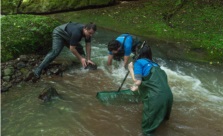
Aiming to analyze the water quality of one of major river basins in Rio Grande do Sul, Feevale University Feevale does a research named Biomarkers in Fish to monitor the water quality of Rio dos Sinos. Coordinated by faculty Günther Gehlen, the study, which began in 2013, as methodology of using living organisms, seeks to understand alterations in the environment. Initially, this research used fish of the species Bryconamericus iheringii (lambari as called in Brazil) and now the species like Ancistrus sp (called cascudo) are also taken for study.
For the procedure, these animals are collected from different spots of Rio dos Sinos river and two of its major affluents: Rio da Ilha, located between the cities Taquara and Rolante, and Rio Paranhana, which crosses towns such as Três Coroas e Igrejinha. Tissues of fish are used as biomarkers, which means the biological transformations that organisms suffer changes due to the environmental pollution. Once measured, weighed and have their blood and tissues collected (gills and muscle), the animals are subjected to various tests. Then, analyses like the presence of heavy metals in the muscle (bioaccumulation), DNA damage in blood (genotoxicity) and changes in the morphology of the gills (histopathology) are taken. The latter is a biomarker of significant pollution, since the gills are the primary target of the pollutants, given your anatomical location, their physiological functions and your contact with the external environment.
Changes already affected headwaters
Although they offer Rio dos Sinos some support, with an increase in the volume of water for the river, faecal coliform levels increase from 800 MPN/10* in the stretch of water between Rio da Ilha and Paranhana to 12.000 MPN/10 (beyond Paranhana river mouth). In addition, the Rio da Ilha’s headwater (as well as Paranhana), located amidst native forest, has already shown changes with the used bioindicators. In the analysis of fish muscle, higher levels of Chromium (Cr), Plumbum (Pb) and Nickel (Ni) were revealed in comparison to the river mouth.
The sources of pollution arise out of several pressures, such as population increase, release of companies effluents, fuels and, in particular, the lack of human sewage treatment. Another mitigating factor can be the creation of cattle and pigs, because often the waste is directly discharged into the river. This demonstrates that the changes can occur even wherever there is not a process made up of urbanization, resulting in polluted springs.
Heavy metals are molecules that can cause harmful effects to various bodies of animals, as, also, to humans. This can cause skin irritation, liver and irreversible kidney damage, as well as neurological effects.
MPN: most probable number * (unit of measure used for the count of bacteria; are acceptable values below 200)





